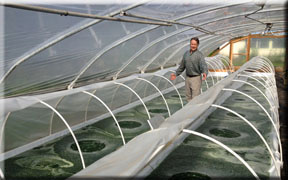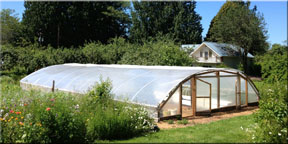Algae farms are often located in hot sunny desert or tropical locations, but new spirulina algae microfarms in the Pacific Northwest are testing features for growing algae in more northern temperate climates.

< Algae growing ponds have retractable and removable greenhouse covers. In cooler seasons, ponds are covered at night to retain warmth. In summertime, covers are completely removed.
Growing local vegetables in gardens and rooftop farms in urban areas around the world is a popular trend. Many urban farms use greenhouses with hydroponic and aquaponic systems to extend the natural growing season. Now high value microalgae, like spirulina, can diversify greenhouse food production and enhance revenues.

Will algae microfarms become new food crops for rooftop farms in cities around the world?
Over 30 years spirulina algae has gained global recognition as a superfood supplement. Published international research shows how consuming small amounts boost immune function, enhance detoxification, restore beneficial intestinal flora, improve neurological function and rally the body’s own healing response. For these reasons spirulina commands premium prices.

< The first Pacific Northwest spirulina microfarm near Olympia Washington. This eco-region has a temperate rainforest climate with warm sunny summers and wet cloudy cool winters.
These new algae microfarms are modular and scalable greenhouse systems with smart monitoring systems and web cameras so remote experts can successfully guide local operations at many locations simultaneously. With insulated ponds and efficient LED lighting and heating systems, the algae growing season can be extended in northern climates well beyond the typical short 4 or 5 months.
Smart Microfarms’ CEO Robert Henrikson founded one of the world’s first and largest algae farms, Earthrise Spirulina in Southern California, 35 years ago. He explains his own evolution from large to small farms. “For decades, algae have been grown on large commercial farms with extensive technical staffing and infrastructure. Now the time has come to introduce algae microfarms to grow healthy foods in local communities. Algae microfarms are simplified and affordable systems with lower cost of entry, and can be enhanced by automation and web-based monitoring systems to reduce the need for experts on site. Profitable business models already exist.”
The Pacific Northwest algae microfarm testbeds will develop metrics for microfarm operations and productivity especially for temperate climates. They will test practical, affordable and replicable systems for growing algae for local food and high value products in community, urban, rooftop, mobile and vertical gardens to demonstrate how microfarms can transform any small food growing area into higher income generating food products.
Smart Microfarms can help terrestrial, hydroponic and aquaponic greenhouse farms diversify income stream with high-value algae food products.
